Survey of the Discovery Site of the Yukagir Mammoth (June)
June 21, 2004
1. Survey travel itinerary
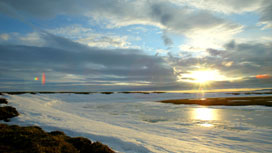
The area around the site
June 8
Travel from Yakutsk to Tiksi helicopter base
June 9
Travel to the site by charter helicopter, camp built
June 10
Survey
June 11
Survey, camp dismantled, return to Tiksi
June 12–15
Meeting of Scientific Council for Research on the Yukagir Mammoth in Yakutsk
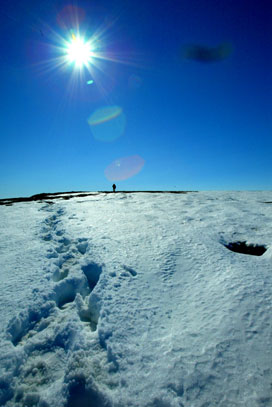
2. Survey team
The survey team consisted of roughly 30 members, including mainly members of the Scientific Council for Research on the Yukagir Mammoth, which is sponsored by the Republic of Sakha (Yakutia), Russian Federation, and is chaired by G. V. Tolstych, Minister of Science and Professional Education, Republic of Sakha.
The survey team had 11 Japanese members, including Naoki Suzuki, vice chairman of the Scientific Council for Research on the Yukagir Mammoth. Other members of the survey team included P. A. Lazarev (Sakha), G. G. Boyeskorov (Sakha), V. N. Potapov (Sakha), Yu. K. Burlakov (Russia), B. Buigues (France), D. Mol (Holland), and J. Shoshani (Eritrea).
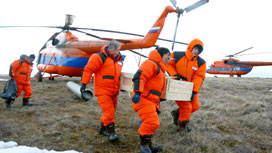
The survey team arrives at the site where the Yukagir Mammoth was discovered
3. Outline of the excavation site and survey
The Yukagir Mammoth was discovered by the southern bank of a river some 30 kilometers east of the village of Yukagir, which is situated in the far northern part of the Republic of Sakha, Russian Federation. The top of the flat riverbank is 4 meters above the water level. The mammoth, beginning with the head, was discovered in the permafrost that begins 1 meter beneath the surface of the riverbank.
At the time of the survey on June 10, most of the snow on the ground near the top of the riverbank had melted, and tundra had begun to grow there. The slope of the riverbank, however, was frozen, and the area near the discovery site remained covered with between 2-4 meters of snow and ice. The survey team worked to clear the snow and ice and expose the discovery site, which was then observed and measured.
Once the snow and ice were removed from the slope of the riverbank, it was confirmed that what remained included the hair of the Yukagir Mammoth and food and other contents of a digestive organ believed to be an intestine. In addition, the dimensions of the site were measured and the land features recorded, steps that are necessary for further excavation work to take place in the future.
Also, the left front leg of the mammoth, which was discovered by a survey team that was active mainly in the Republic of Sakha last fall and had been preserved in the permafrost nearby the site, was excavated and shipped in its frozen state to the Institute of Applied Ecology of the North in Yakutsk in a large freezer.
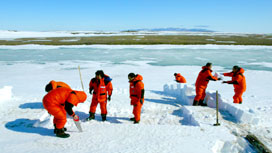
Clearing the snow and ice away at the site
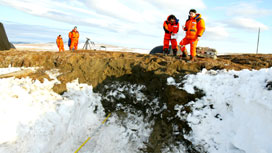
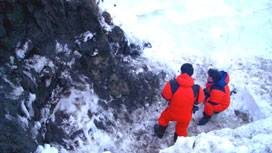
Confirming and measuring the site
4. Condition and findings concerning mammoth parts discovered to date
The head, which was discovered by the survey team mentioned previously that had examined the Republic of Sakha, contains soft tissue and two intact tusks that had been preserved over time. In addition to the head, other parts that have been discovered include a nearly complete set of the cervical vertebrae that connect to the head, some thoracic vertebrae, a number of ribs, two shoulder blades, a humerus, and the left front leg with joints still connected.
The parts discovered can be said to have been preserved in excellent condition in comparison with the Berezovska Mammoth and the Baby Mammoth. Not only does the head still have skin with hair attached, the left side of the head has an eye socket with an eyelid, as well as a completely intact ear. It is expected that the brain and other contents inside the head have also been preserved in excellent condition. The left front leg, especially the end, has skin and muscle that have remained almost completely intact. It is believed that it will be possible to conduct research on the inside of the mammoth's head and on its physical capabilities by means of X-rays and CT scans.
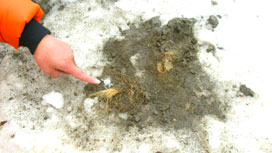
The hair of the Yukagir Mammoth at the site
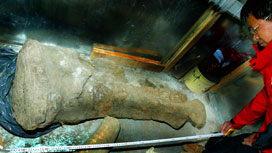
The left front leg, which had been preserved in the permafrost near the site
Based on the circumstances at the location where the Yukagir Mammoth was discovered, it is believed that the body of the mammoth was located in the permafrost at an angle, with its body facing upward and its back and left side at the bottom. At present, the parts of the body that are comparatively near the front have been discovered, and the back half of the specimen has yet to be found. It is unclear whether the back half remains in the permafrost in the area, or has been moved elsewhere by the elements. While the survey team took with it subterranean radar to Tiksi, that equipment regrettably became unusable shortly before the departure of the helicopter, so it was not employed during this survey. Subterranean surveys are planned during the process of future excavation work.
The question of whether the Yukagir Mammoth died at the location where it was discovered or whether it died elsewhere and was transported there afterward is one that will likely be answered during a future geological survey of the area.
Further surveys of the area are planned for the future, including at the end of August. Additionally, the following types of research were agreed upon at the meeting of the Scientific Council.
- Geological and pedological surveys of the site, as well as research on the process of fossilization
- Research on the external structures of the mammoth, as well as on the internal structures using nondamaging methods
- Histological, cytological, and genetic research on the mammoth's soft tissue
- Paleobotanical and paleoclimatologic analysis
- Microbiological research on the soil and the inside of the mammoth
Attached photographs (color copies) of the survey in Sakha are available either as printed pictures or as data. It is also possible to borrow betacam tapes of the video footage, so those wishing to do so, and for more information, please contact:


